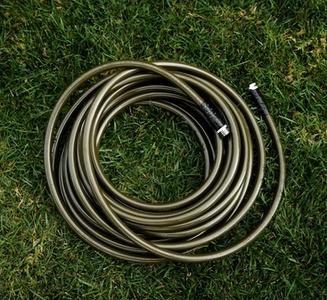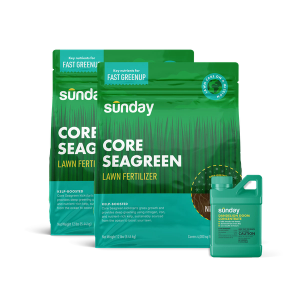What is a full lawn repair?
If you have a lawn (which you probably do because, well, you’re reading this!) it’s inevitable that it will need some sort of repair or renovation at some point in time. Lawn damage can range in intensity anywhere from light neglect that can be resolved with regular maintenance to a full overhaul requiring advanced repairs. So, how "full" are we talking?
A full lawn repair means replacing or replanting grass across more than 50 percent of your lawn. This is usually required only when more than half of the lawn is struggling, or when the lawn would generally benefit from a renovation.
Signs that you need a full lawn repair
There are two main reasons why a lawn might need a full repair. Let's dive in and see if it sounds like your situation.
- There are signs of one (or more!) of these severe problems:
- At least 50% of the lawn is bare or thinning.
- At least 50% of the lawn is covered with hard-to-remove weeds like grass, sedge, or hardy perennials (ex. perennial grassy weeds like quackgrass, dallisgrass, or a sedge like nutsedge).
- You want to make a major change that will allow for better growth and improve your lawn long term. This could just mean you want to replace your existing turf with a species that's better for your climate.
Signs that you don't need a full lawn repair
Think your lawn might need a full repair? Use our guide to determine if you can avoid one! If any of the instances below reflect your lawn, you probably don't need a full lawn repair. Whew!
- Minor neglect: If your lawn has a few weeds (let's be real, don't we all?), but is mostly filled in and green, you can relax. This lawn just needs proper watering, mowing, weeding, and feeding to get back to good shape.
- Some work: Maybe your lawn has a few areas of thin, bare patches or some errant weeds—or even heavy traffic from pets or kids. This lawn needs a few small patching jobs, topdressing, and basic lawn care.
- Large repair: This looks like a lawn with areas of thinning or bare patches, along with weeds, but those are affecting less than half the lawn. This lawn borders on a full repair, but heavy overseeding, strategic mowing for weed control, and proper basic care can keep you from a full-blown repair.
Heads up! Lawn repair often requires specialized equipment, plus extensive time, labor, and cost. Before opting for full lawn repair or renovation, first determine if other solutions are more feasible or if partial lawn renovation is more suitable (prior to embarking on this journey).
How to repair your lawn
First, breathe! You've got this. If you’ve decided that your lawn does in fact need a full repair, follow this step-by-step guide:
- Start with a soil test. This will help you figure out whether your lawn has a nutrient deficiency or low soil fertility.
- Solve the underlying problem(s) first—otherwise, any work you do will eventually succumb to the same damage. Here are some of the most common underlying issues:
- Drought and heat
- Winterkill
- Turf pest damage
- Poor watering or mowing practices
- Disease
- Soil compaction
- Shade and competition from trees
- Determine the size of the repair area. If it's greater than 50 feet, you may need special equipment.
- Determine the best time to renovate your lawn based on whether you have a cool-season or warm-season grass type.
- Cool-season grass (fine fescue, tall fescue, perennial ryegrass, and Kentucky bluegrass) should be repaired during the early spring or early fall.
- Warm-season grass (bermudagrass, buffalograss, centipedegrass, Kikuyugrass, St. Augustinegrass, and zoysiagrass) should be repaired during the late spring or early summer.
- Determine how to remove your existing grass and weeds, since you'll be restarting from scratch. This will require you to either mow low (removing clippings, leaves, and debris), use an herbicide to kill grass, or remove it with a sod cutter.
- Prep the soil for new seeds or sod. Cultivate the soil with a pitchfork (light tilling) in smaller areas, or in larger properties you can use specialized equipment (aeration machine or heavy-duty cultivator). During this step, make sure to remove remaining weeds that are deeply rooted in the soil.
- Plant grass according to grass type. Spread seeds heavily or hire a pro to install sod.
- Water the new grass appropriately to get it established. Hint: Watering is very different between seed and sod!
- Work on proper lawn management: watering, mowing, and feeding.
Sunday tips for a successful lawn repair
Following our best practices for lawn repair can mean the difference between growing a better lawn year after year, or repeating this repair and replacement process again and again. To keep the lawn of your dreams, follow these tips:
- Water like you want your grass to stick around. Properly irrigate your grass seeds to germination (or sod to establishment), and then adjust to regular deep and infrequent watering practices.
- Stay off of the lawn. We know, you're probably itching to get out on your new grass! But as much as possible, wait to start using these areas until the grass has established. Avoid foot traffic in extra sensitive areas by fencing them off from pets, kids, and wildlife.
- Cut the grass only when it hits the right height. Return to regular mowing practices when the lawn reaches the proper mowing height for your specific grass species.
- Hold off on fertilizer until the right time. Wait until more than 60 percent of the lawn has germinated to apply fertilizer to new grass seedlings. For new sod, wait about five to six weeks (because sod comes pre-fertilized).
Long-term benefits of lawn repair
Beyond reducing weeds, bare areas, and thinning in the short term, there are plenty of reasons why your full lawn repair will help you long term.
Introducing better grass species
If you introduced new grass varieties better suited to your climate, your lawn will be more resilient. This could mean it's more suited to your current landscape (e.g. shade), water availability, and turf pest presence.
Repairing soil issues long-term
If you fixed underlying issues—so the problem doesn’t recur—you'll be rewarded with more cost-effective lawn management, saving you money and time.
A more self-sustaining lawn
If you replaced your lawn with thicker, denser turf and healthy soil, you’ll have a more sustainable lawn—which means less mowing, less tilling, and less watering required to keep it healthy.
Cited sources
Lawn Renovation. Cornell Cooperative Extension.
Renovation of Lawns. PSU Extension.
Renovating the Home Lawn. Colorado State University Extension.
Sustainable Lawns. Cornell Cooperative Extension.



















